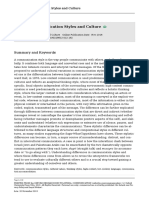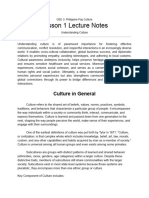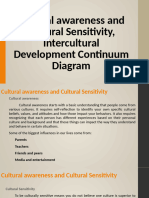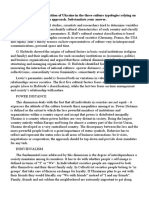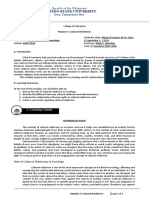Download
Download
Uploaded by
Priyanka ChhabraCopyright:
Available Formats
Download
Download
Uploaded by
Priyanka ChhabraOriginal Description:
Original Title
Copyright
Available Formats
Share this document
Did you find this document useful?
Is this content inappropriate?
Copyright:
Available Formats
Download
Download
Uploaded by
Priyanka ChhabraCopyright:
Available Formats
6/28/23, 9:52 PM about:blank
PMAL101: Cross-Cultural Communication
Unit 8: Theories and Research in Cross-Cultural
Communication
What do you understand about how people think and behave across cultural contexts?
Refer to Figure 2.3 found in this chapter (or within the Resources tab in this activity) and
provide your views or personal experiences on how people behave in high vs. low
cultural contexts.
Response:
It's crucial to remember that cultures are varied and complex, and that people from different cultural
backgrounds can coexist. Therefore, it is important to use caution when making any generalizations.
Influences from culture: Culture has a big impact on how people think and act. People's perspectives on
the world, interactions with others, and decision-making are influenced by cultural values, norms,
beliefs, and traditions. People are socialized within the contexts of their respective cultures, picking up
the traditions, norms, and proper conduct of those societies. Cultural contexts can have an impact on
communication styles. Indirect and implicit communication may be valued more highly in some
cultures than direct and explicit communication. Individualistic cultures frequently put an emphasis on
self-interest, independence, and self-expression, whereas collectivistic cultures put an emphasis on
maintaining social ties, group harmony, and interdependence. While some cultures place a strong
emphasis on efficiency and punctuality, following set schedules and deadlines, others may take a more
accommodating and laid-back approach to time. Attitudes toward Authority: Different cultural
contexts can result in different attitudes and behaviors toward authority figures. Others may have
wider personal space boundaries and prefer more personal distance during interactions. Some cultures
may have smaller personal space boundaries and frequent physical contact. The emergence of
multicultural identities and the further blending of cultures as a result of globalization and increased
intercultural interaction have further complicated our understanding of human thought. According to
the given figure and according to my personal experience, people in low culture behaves informally,
popularity oriented, relaxed standards and easily accessible. Where in high culture people being more
formal, selective, intellectually curious and intellectually pursuitable.
Word Count: 276
about:blank 1/1
You might also like
- Rainbow Warrior ArbitrationDocument3 pagesRainbow Warrior ArbitrationKris HannahNo ratings yet
- Learning Activity Sheets: Direction: Read Each Statement Carefully. On The Space ProvidedDocument8 pagesLearning Activity Sheets: Direction: Read Each Statement Carefully. On The Space ProvidedMyrimar Simbajon100% (3)
- WeaveTech SolutionDocument2 pagesWeaveTech Solutionjennifer aj100% (1)
- Ch. 20 - Second Law of ThermodynamicsDocument36 pagesCh. 20 - Second Law of ThermodynamicsMark Ronald SuaisoNo ratings yet
- Chapter 06 Diverse Work EnvironmentDocument21 pagesChapter 06 Diverse Work EnvironmentAbhinav SuneethNo ratings yet
- Introduction The Influence of Culture On Human BehaviorDocument8 pagesIntroduction The Influence of Culture On Human BehaviorrhanfrancisabrauNo ratings yet
- Mid Term Lessons On Purposive CommunicationDocument13 pagesMid Term Lessons On Purposive CommunicationJessarlyn GumialNo ratings yet
- Communicating in A Multicultural Society and WorldDocument5 pagesCommunicating in A Multicultural Society and WorldErna Mae Alajas100% (1)
- Introduction The Influence of Culture On Human BehaviorDocument8 pagesIntroduction The Influence of Culture On Human BehaviorrhanfrancisabrauNo ratings yet
- Heritage Notes Marriages, Dance EtcDocument43 pagesHeritage Notes Marriages, Dance Etcmakunderonald18No ratings yet
- Theory of Cultural Determinism: CultureDocument8 pagesTheory of Cultural Determinism: CultureJohn Stanley100% (1)
- Cross Cultural NegotiationDocument17 pagesCross Cultural NegotiationAditzaSterNo ratings yet
- Chapter 2 - Culture and Interpersonal CommunicationDocument26 pagesChapter 2 - Culture and Interpersonal CommunicationJessa Mea RioNo ratings yet
- Adapting Communication To Cultures and Social CommunitiesDocument14 pagesAdapting Communication To Cultures and Social CommunitiesCINDY BALANONNo ratings yet
- Intercultural Communication FinalDocument7 pagesIntercultural Communication FinalVenkata Manikantha AllagaddaNo ratings yet
- National Culture and Its Impact On Organizational BehaviorDocument49 pagesNational Culture and Its Impact On Organizational Behaviorpooja8288100% (1)
- GE PC Chapter 2Document12 pagesGE PC Chapter 2Qwertyuiop QwertyuiopNo ratings yet
- Week 7 Local and Global CommunicationDocument14 pagesWeek 7 Local and Global CommunicationkatrizmaervillagantolNo ratings yet
- Personal Culture ReflectionDocument7 pagesPersonal Culture ReflectionMezab E RehmatNo ratings yet
- 66 - PDFsam - Joseph A. DeVito - Human Communication - The Basic Course-Pearson (2018)Document1 page66 - PDFsam - Joseph A. DeVito - Human Communication - The Basic Course-Pearson (2018)Mási de LaféNo ratings yet
- Cultural MemoryDocument35 pagesCultural MemoryHector Manuel Jon BrizuelaNo ratings yet
- REFLECTION PAPER 3 - Module 3 and 4Document6 pagesREFLECTION PAPER 3 - Module 3 and 4Caburnay, Ma. Mhika Francess P.No ratings yet
- C D W Ii ChapterDocument6 pagesC D W Ii ChaptervvbbbvgbbbbnnNo ratings yet
- Communication I WPS OfficeDocument18 pagesCommunication I WPS OfficeYbañez, Jayson D.No ratings yet
- Topic 5 Ethnocentrism and Cultural RelativismDocument2 pagesTopic 5 Ethnocentrism and Cultural RelativismMarilyn Dizon100% (2)
- Culture and IdentityDocument1 pageCulture and IdentityБалауса ЕрболкызыNo ratings yet
- Intercultural CommunicationDocument5 pagesIntercultural Communicationcorteswen058No ratings yet
- Verbal Comm Styles and CultureDocument16 pagesVerbal Comm Styles and CultureValerie1 Valeria100% (1)
- GEE 3 Midterm Lecture NotesDocument32 pagesGEE 3 Midterm Lecture NotesmanzanoraiNo ratings yet
- Purcomm Pre Finals Reviewer 1Document35 pagesPurcomm Pre Finals Reviewer 1Vanessa LagrimasNo ratings yet
- An Introduction To Communication - Intercultural Communication - Ecampus-FlshDocument3 pagesAn Introduction To Communication - Intercultural Communication - Ecampus-FlshMohamed LahkimNo ratings yet
- Cce - Giao Thoa Văn HoáDocument5 pagesCce - Giao Thoa Văn HoáTrần TrangNo ratings yet
- Purposivecomm ReportDocument21 pagesPurposivecomm ReportJM DacilloNo ratings yet
- Week 5 (BC-HS 218)Document19 pagesWeek 5 (BC-HS 218)razaaziz9191No ratings yet
- Konspektas CCMCDocument32 pagesKonspektas CCMCMarija DambrauskaitėNo ratings yet
- Cultural Awareness and Cultural Sensitivity, Intercultural DevelopmentDocument11 pagesCultural Awareness and Cultural Sensitivity, Intercultural DevelopmentNoel BarcelonNo ratings yet
- Seminar 3Document4 pagesSeminar 3kidpursuitNo ratings yet
- BU VITA Cross CultureDocument11 pagesBU VITA Cross CultureAldi SubagioNo ratings yet
- Cultural Competence ModelDocument18 pagesCultural Competence ModelLarry MagwegweNo ratings yet
- Purposive Communication Finals ScopeDocument166 pagesPurposive Communication Finals ScopeYriel GuilaranNo ratings yet
- CCC Meet 2Document15 pagesCCC Meet 2desi suciNo ratings yet
- Intercultural CommunicationDocument14 pagesIntercultural CommunicationMary Ann R. Mora100% (1)
- Culture and Sustainable DevelopmentDocument23 pagesCulture and Sustainable DevelopmentStephen OkelloNo ratings yet
- Lesson 3:: Culture in Moral BehaviorDocument19 pagesLesson 3:: Culture in Moral BehaviorManiya Dianne ReyesNo ratings yet
- Fundamental Attribution Error: Vocabulary 2013Document4 pagesFundamental Attribution Error: Vocabulary 2013mary engNo ratings yet
- Cultural Orientations and Putting The Cultural Profiles in ContextDocument5 pagesCultural Orientations and Putting The Cultural Profiles in ContextTaj uroosaNo ratings yet
- Etnocentrism and Cultural RelativismDocument4 pagesEtnocentrism and Cultural RelativismMa. Abegail MacapobreNo ratings yet
- Smmative Test in UCSPDocument4 pagesSmmative Test in UCSPKen Stephen RheyNo ratings yet
- Running Head: Cross-Cultural Communication 1Document10 pagesRunning Head: Cross-Cultural Communication 1Karem SalinasNo ratings yet
- pdfsCrossCulturalUnderstanding PDFDocument10 pagespdfsCrossCulturalUnderstanding PDFChaplin AttitudeNo ratings yet
- Lesson Number 3 Intercultural CommunicationDocument6 pagesLesson Number 3 Intercultural CommunicationKyla Marie Vien D MacayanNo ratings yet
- UTS Activity 3 Assessment 3 PDFDocument1 pageUTS Activity 3 Assessment 3 PDFJein Graceilyn L. CabangonNo ratings yet
- Pop Culture Prelim Reviewer PDFDocument18 pagesPop Culture Prelim Reviewer PDFMIGUEL RAZONNo ratings yet
- Adapting Communication To Cultures and Social CommunitiesDocument3 pagesAdapting Communication To Cultures and Social CommunitiesYohana MargarethNo ratings yet
- Concepts Variations of CultureDocument4 pagesConcepts Variations of Culturekisses ChoochooNo ratings yet
- Cultural Differences Should Not Separate Us From Each OtherDocument4 pagesCultural Differences Should Not Separate Us From Each OtherKathe Tanael TabuzoNo ratings yet
- City College of Tagaytay: Republic of The PhilippinesDocument16 pagesCity College of Tagaytay: Republic of The PhilippinesJeff Jeremiah PereaNo ratings yet
- Partido State University: Goa, Camarines SurDocument5 pagesPartido State University: Goa, Camarines SurRalph NavelinoNo ratings yet
- Liên SummaryDocument4 pagesLiên SummaryKim Liên NguyễnNo ratings yet
- ? Midterm - Module 4-Communication in Multicultural SettingsbDocument20 pages? Midterm - Module 4-Communication in Multicultural SettingsbSARABIA, ARVIN JR.No ratings yet
- Chapter 3 Culture and BusinessDocument3 pagesChapter 3 Culture and BusinessLe ZymNo ratings yet
- Unit Iii. Local AND Global Communication IN Multicultural SettingDocument7 pagesUnit Iii. Local AND Global Communication IN Multicultural SettingHaruka NanaseNo ratings yet
- Meetings and ResolutionsDocument5 pagesMeetings and Resolutionsabhishek singh100% (1)
- Agreement For Personal Power LoanDocument2 pagesAgreement For Personal Power Loansaurabh singhNo ratings yet
- Grade Book - 11 Humss-5Document5 pagesGrade Book - 11 Humss-5Zina Arrdee D. Alcantara (Lunduyan 2)No ratings yet
- Islamic Financial Management: AssignmentDocument20 pagesIslamic Financial Management: AssignmentIbrahim LatheefNo ratings yet
- Province Wise Literacy RateDocument6 pagesProvince Wise Literacy RateMashavia AhmadNo ratings yet
- Core Salary With ConversionDocument56 pagesCore Salary With ConversioncontourmxNo ratings yet
- Barangay Certification PsaDocument3 pagesBarangay Certification PsaBarangay BaculanadNo ratings yet
- (Platinum Membership) : Certificate of Philgeps RegistrationDocument3 pages(Platinum Membership) : Certificate of Philgeps RegistrationRobert Mequila IINo ratings yet
- The Role of International Organizations in Shaping Philippine PoliciesDocument28 pagesThe Role of International Organizations in Shaping Philippine Policiesashley joyNo ratings yet
- Ebook PDF Civil Procedure in A Nutshell Nutshells 8th Edition PDFDocument47 pagesEbook PDF Civil Procedure in A Nutshell Nutshells 8th Edition PDFphilip.pelote179100% (51)
- Truth in Lending ActDocument2 pagesTruth in Lending ActGabieNo ratings yet
- How To Become An EntrepreneurDocument4 pagesHow To Become An EntrepreneurAndrej DimovskiNo ratings yet
- 31 HiraDocument1 page31 HiraMD AbdullahNo ratings yet
- Filipino10 - q2 - Mod6 - Sanaysay Talumpati Ni Dimla RousseffDocument25 pagesFilipino10 - q2 - Mod6 - Sanaysay Talumpati Ni Dimla RousseffCharles Bernal100% (3)
- 3) Gratuity Nomination (Form F)Document3 pages3) Gratuity Nomination (Form F)Vinod kumarNo ratings yet
- Student PassportDocument6 pagesStudent Passportapi-233755289No ratings yet
- Idk 22Document4 pagesIdk 22bao002785No ratings yet
- KerDocument8 pagesKerRey LacadenNo ratings yet
- (Grant & Temperley's Europe in The Nineteenth & Twentieth Century, 2) Agatha Ramm - Europe in The Twentieth Century 1905-1970-Routledge (2017)Document440 pages(Grant & Temperley's Europe in The Nineteenth & Twentieth Century, 2) Agatha Ramm - Europe in The Twentieth Century 1905-1970-Routledge (2017)Oct888No ratings yet
- University of Vaasa - Tuition Fee Refund PolicyDocument1 pageUniversity of Vaasa - Tuition Fee Refund PolicyYodahe GetuNo ratings yet
- 1 - CTA Paper IVDocument4 pages1 - CTA Paper IVMahmozNo ratings yet
- Martin Luther KingDocument3 pagesMartin Luther KingTam WatkinsNo ratings yet
- 5 - BDRRMCDocument2 pages5 - BDRRMCsan nicolas 2nd betis guagua pampangaNo ratings yet
- Modus Operandi of Cheating by Personation and Its Impact On The Progress of SocietyDocument18 pagesModus Operandi of Cheating by Personation and Its Impact On The Progress of SocietyPooja MishraNo ratings yet
- Motion To Dismiss by Sheriff Nick Smith, in His Official CapacityDocument4 pagesMotion To Dismiss by Sheriff Nick Smith, in His Official CapacityABC 33/40No ratings yet
- Practice Problem From IntegrationDocument1 pagePractice Problem From IntegrationS.M. Fauzul AzimNo ratings yet
- Document Checklist and QuestionnaireDocument6 pagesDocument Checklist and QuestionnaireKhadimulHasanTarif100% (1)



























